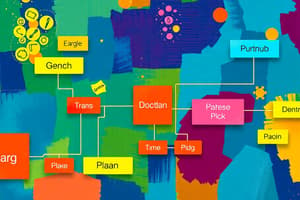Podcast
Questions and Answers
What are the correct components of a graph model structure?
What are the correct components of a graph model structure?
- Vertices, Indexes, Connections
- Edges, Weights, Vertices
- Nodes, Edges, Labels for edges (correct)
- Nodes, Paths, Lists
Which of the following represents a numeric form of graph representation?
Which of the following represents a numeric form of graph representation?
- Bar chart
- Visual diagram
- Adjacency matrix (correct)
- Tree structure
Which type of graph is characterized by having two distinct sets of nodes connected by edges?
Which type of graph is characterized by having two distinct sets of nodes connected by edges?
- Connected graphs
- Trees
- Bipartite graphs (correct)
- Directed graphs
What generic question can be asked regarding the properties of a graph?
What generic question can be asked regarding the properties of a graph?
In a graph, what does a path represent?
In a graph, what does a path represent?
Which term describes a connection between two nodes in a graph?
Which term describes a connection between two nodes in a graph?
Which of the following represents a visual form of graph representation?
Which of the following represents a visual form of graph representation?
In which type of graph do all nodes need to be reachable from one another?
In which type of graph do all nodes need to be reachable from one another?
What is an adjacency matrix used for in graph theory?
What is an adjacency matrix used for in graph theory?
Which type of graph is commonly used to represent relationships across two distinct sets of nodes?
Which type of graph is commonly used to represent relationships across two distinct sets of nodes?
Flashcards
Graph Structure
Graph Structure
A way of representing data using nodes (vertices) and edges (connections).
Nodes (Vertices)
Nodes (Vertices)
The individual components in a graph structure.
Edges
Edges
Connections between nodes in a graph.
Directed Edge
Directed Edge
Signup and view all the flashcards
Undirected Edge
Undirected Edge
Signup and view all the flashcards
Graph Label
Graph Label
Signup and view all the flashcards
Adjacency Matrix
Adjacency Matrix
Signup and view all the flashcards
Visual Representation
Visual Representation
Signup and view all the flashcards
Trees
Trees
Signup and view all the flashcards
Series-Parallel Networks
Series-Parallel Networks
Signup and view all the flashcards
Bipartite Graph
Bipartite Graph
Signup and view all the flashcards
Connected Graph
Connected Graph
Signup and view all the flashcards
Path
Path
Signup and view all the flashcards
Graph Properties
Graph Properties
Signup and view all the flashcards
Graph Structure
Graph Structure
Signup and view all the flashcards
Nodes (vertices)
Nodes (vertices)
Signup and view all the flashcards
Edges (connections)
Edges (connections)
Signup and view all the flashcards
Directed Edge
Directed Edge
Signup and view all the flashcards
Undirected Edge
Undirected Edge
Signup and view all the flashcards
Graph Label
Graph Label
Signup and view all the flashcards
Adjacency Matrix
Adjacency Matrix
Signup and view all the flashcards
Visual Representation
Visual Representation
Signup and view all the flashcards
Tree (graph)
Tree (graph)
Signup and view all the flashcards
Series-Parallel Networks
Series-Parallel Networks
Signup and view all the flashcards
Bipartite Graph
Bipartite Graph
Signup and view all the flashcards
Connected Graph
Connected Graph
Signup and view all the flashcards
Path (graph)
Path (graph)
Signup and view all the flashcards
Graph Properties
Graph Properties
Signup and view all the flashcards
Study Notes
Business Intelligence - Lecture 2 Summary
-
Model Definition: Models represent portions of a business process, enabling precise formulation of analytical questions.
-
Representation Function: Crucial for realizing the model's representation.
-
Model Language: Enables the proper formulation of representations.
-
Models of Phenomena: These models portray aspects of business processes relevant for analytical purposes.
-
Phenomena: Features within the business process of interest for analysis.
-
Caricatures: Models simplify phenomena for practical use.
-
Idealized Models: Models based on simplified processes like business operations, treatments, or course designs.
-
Analogical Models: Employ ideas from other scientific domains e.g., gravity model.
-
Phenomenological Models: Statistical models, like regression, are used.
-
Models of Data (Machine Learning/Data Mining): Learning the most appropriate models are critical for data analysis.
-
Models of Theories: Models representing formal systems (ontologies)
-
Understanding of formal systems: Defining theories from data instances.
-
Languages for Models: Specific languages like BPMN for process flow modeling exist.
-
Formulation of Models: Each language has specific semantic for defining model elements in a specific problem.
-
Model Structures (Syntax/Semantic):
- Syntax: Defines basic elements and their combination rules.
- Semantic: Defines the meaning of model elements independent of the domain.
- Notation: Provides a clear way to communicate model expressions.
- Model Elements: Specific components to represent the business process.
- Generic Questions: Analytical inquiries regarding model elements.
-
Modeling (Conceptual Modeling): Mapping domain semantics into suitable model configurations.
-
Model Configuration: Allow for the formulation of analytical questions (admissible expressions).
-
Connections with Observations: Model configurations should align with business data observations.
-
Model Variability: Addresses the nuances and variations of real-world data. Statistical variability can affect data precision.
-
Model Quality (Assessment):
- Correctness: Model structure and domain interpretation are correct.
- Relevance: Model function meets intended purposes.
- Economic Efficiency: Balance between model's complexity and cost.
- Clarity: Model's ease of understanding.
- Comparability: Model's ability to function within the overall analysis framework.
- Objectivity: Results aren't affected by the user's biases.
- Reliability: Consistent results.
- Validity: Practical usefulness.
- Content Validity: Model accurately reflects the essential features.
- Criterion Validity: Correlation with other known methods.
- Construct Validity: Ability to derive new insights from the model.
-
Models and Patterns:
- Patterns: Describe local behaviors.
- Models: Describe broader behaviors.
-
Graph Structures (Model Language):
- Syntax: Includes nodes, directed and undirected edges (connections).
- Notation: Numerical (e.g., adjacency matrices) and visual representations are employed.
- Model Elements: Various graph structures (trees, networks, bipartite graphs).
- Generic Questions: Queries about graph properties.
-
Data Generation:
- Data Types: Transactional, administrative and web data are pertinent.
- Population Definition: Defining the group or entity represented by the data (e.g. customers, reviews etc.).
- Measurements: Precisely quantifying data qualities.
Studying That Suits You
Use AI to generate personalized quizzes and flashcards to suit your learning preferences.




